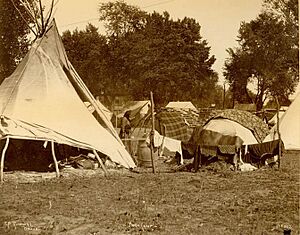Indian Congress facts for kids
The Indian Congress was a special event held in Omaha, Nebraska, in 1898. It took place from August 4 to October 31. This gathering was part of a bigger event called the Trans-Mississippi International Exposition.
It was the largest meeting of American Indian tribes up to that time. More than 500 people from 35 different tribes came together. Famous leaders like Geronimo, an Apache medicine man, were also there. He was being held by the United States government at Fort Sill at the time.
The event happened about ten years after the American Indian Wars ended. These wars were conflicts between Native American tribes and the U.S. government.
Photographs taken by Frank A. Rinehart at the Indian Congress are very important. They show many Native American leaders from around the year 1900. These pictures are considered some of the best records of the time.
Contents
Why the Indian Congress Happened
The idea for the Indian Congress came from Edward Rosewater. He owned a newspaper called the Omaha Bee. Rosewater was a very important person and a friend of President William McKinley.
He worked hard with others to get the event approved. In 1897, a plan was introduced in the United States Congress. It asked for $100,000 to hold the Indian Congress.
The plan passed in the United States Senate. However, the Spanish–American War made the United States House of Representatives busy. They could not vote on the bill right away.
In July 1898, President McKinley approved $40,000 for the event. This money came from the Indian Appropriations Act. The Bureau of American Ethnology, part of the Smithsonian Institution, also helped with funding.
What the Indian Congress Was About

The Indian Congress was managed by ethnologist James Mooney. Army Captain William Mercer also helped. They worked under the Bureau of Indian Affairs.
The main goal was to show how different tribes lived. They wanted to display their daily life, crafts, and unique customs. Families from many tribes camped in their traditional homes. These included tepees, wigwams, and hogans.
They were allowed to live as they did at home. They could also make and sell their crafts for their own profit. This helped visitors learn about their cultures.
Activities and Weather
When the Congress opened, organizers noticed something. Visitors wanted to see exciting performances. They were interested in dances, games, races, ceremonies, and mock battles.
So, the main activities became re-enactments. The Ghost Dance also became a popular part of the event.
The weather during the Congress was very difficult. Captain Mercer reported extreme heat and dry, hot winds. This made camp life uncomfortable. Later, there was a week of cold, heavy rains. This made conditions even worse for the people living in the camps.
Different Ideas for the Congress
Ethnologist Mooney wanted the Congress to show real tribal customs. However, the event promoters had different ideas. They built a large grandstand for 5,000 people. They arranged for tribes to re-enact battles.
There were also concerns about the Ghost Dance. The United States Army had attacked dancers during the Wounded Knee Massacre in 1890. But the managers of the Exposition encouraged the Ghost Dance. A local newspaper said it became a very popular attraction.
Important Photographs by Frank A. Rinehart
James Mooney hired Frank A. Rinehart and Adolph Muhr to take pictures. They photographed many of the people who attended the Congress.
Rinehart took hundreds of photos. These pictures are seen as one of the most complete collections of Native American portraits. They show people as they were, without trying to make them seem strange or "exotic." Rinehart and Muhr took their photos in a studio on the Expo grounds.
Merry Foresta, from the Smithsonian Photography Initiative, praised Rinehart's work. She said his portraits were "extraordinary." She noted that the quality of his work made him stand out from other photographers of that time.
Tribes That Attended
More than 500 people from 35 different tribes came to the Indian Congress. Some of the tribes included:
- Apache
- Arapaho
- Assiniboine
- Blackfoot
- Cheyenne
- Chippewa
- Crow
- Flathead
- Fox
- Iowa
- Kiowa
- Omaha
- Otoe
- Ponca
- Potawatomi
- Sauk and Fox
- Lakota
- Southern Arapaho
- Tonkawa
- Wichita
- Winnebago
- Santa Clara Pueblo
The idea of having "Indian Congresses" at big events continued. Similar gatherings were held at the Pan-American Exposition in 1901 and the Louisiana Purchase Exposition in 1904.
Image gallery
The following pictures were all taken by Frank Rinehart and Adolph Muhr at the Indian Congress in Omaha.
-
Hattie Tom, Chiricahua Apache.
-
Touch the Clouds, Minneconjou Teton Lakota chief
-
Sarah Whislter, Sauk and Fox woman.
-
Yellow Shirt, Hunkpapa Sioux chief.
-
White Buffalo, Cheyenne chief.
-
Wah-Ta-Waso, Iroquois woman.
-
Freckle Face, Arapaho woman.
-
Bonie Tela, San Carlos Apache; and Hattie Tom, Chiricahua Apache.
-
Little Snake, Omaha Tribe interpreter.
-
Moni Chaki, Ponca chief.
-
Naiche, Chiricahua Apache chief.
-
Geronimo, Chiricahua Apache leader.
-
(standing) Joe Merrivale, Young Spotted Tail, Antoine Janis. Seated: Touch the Clouds, Little Big Man, Black Cool, unknown
















